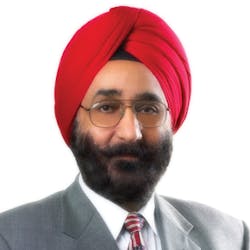This file type includes high resolution graphics and schematics when applicable.
CD: Many themes are associated with IMS 2016, such as 5G, the Internet of Things (IoT), and automotive radar, among others. What are some of the main topics concerning these themes that you believe will be discussed?
AK: You are right: 5G, IoT, and automotive radar are some of the themes that run through this year’s IMS presentations and discussions. Related main topics that will be discussed concerning these themes include millimeter-wave technology, power amplifier designs, multi-band radio and synthesizer designs, advanced measurement, and IC technologies.
The plenary session on Monday is about the future of smartphones, which is connecting us with IoT and is expected to provide us with 5G functionality in five years. Closing ceremony keynotes will focus on the role of software 5G microwave systems and evolution of IoT and wearable devices in, on, and around the human body. Out of 36 workshops and tutorials, a large number is related to these themes.
A tutorial on 5G technologies and a workshop on automotive radar for autonomous vehicles are designed to bring the attendees up to speed rapidly. Many other networking and discussion events will center on these themes. A good number of technical paper sessions are also related to these hot topics.
CD: You have been a part of the RF/microwave industry for many years. Did you ever imagine that wireless communications would be as deep-rooted in our lives as it is today?
AK: Not really. It is true that I have watched the RF/microwave industry since the early ’70s, and at the beginning of my career this technology use was really focused on military and aerospace applications. Satellite communications was one of the first applications that impacted our lives by providing a reliable means of long-range communications. Today’s smartphone is obviously a lot more than a phone. The combination of Wi-Fi, GPS, RFID, NFC, Bluetooth, wireless charging, and millions of apps has made the smart phone a “superman” of gadgets, and this was hard to imagine even in fiction in the seventies.
Today we enjoy smart watches, wireless-controlled home thermostats, home lights, wireless key and phone finders, wearable health monitors, Bluetooth enabled hearing aids, wireless monitored homes, cars, etc. With the emerging advances in IoT, 5G, and automotive applications, the interesting thing is that we are essentially only in the beginning stages at this point.
CD: What do you think are some of the most notable technological advancements we have seen in the last 10 years or so?
AK: Number one for me is the smartphone for its wide ranging capabilities to handle voice, data, and video in a user-friendly way. It is literally a computer in your pocket. The millions of apps on smartphones seem to be keeping the world dancing on its little fingers. Today there are 2 billion smartphones in the world, and that number is expected to grow rapidly for the foreseeable future. Other notable technological advances, as I see, include:
- the transition to digital TV, which is enabling high-definition TV in homes;
- Massive MIMO and the modern OFDM-modulation schemes for allowing non point-to-point communications, including enabling robust Wi-Fi;
- GPS for numerous consumer applications. My favorites are precision location finding and real-time traffic information;
- Bluetooth and NFC for short-range communications;
- Advances in sensor technology, which is a key enabler for IoT revolution;
- Wireless charging; and
- The fast-growing technological advance: electric vehicles with driver-assist features.
Let us not underestimate the significance of software’s role in all of these applications. Developments in the software field are enabling newer applications every day.
CD: Millimeter-wave technology has become more of a focus now. What applications do you believe will benefit the most as a result of utilizing these higher frequencies?
AK: Millimeter-wave technology has finally found its place in the commercial and consumer world. This technology offers large bandwidth, ease of frequency use, smaller size, and reduced interference. Even though millimeter waves theoretically cover 30 to 300 GHz, the present focus is limited from 28 to 86 GHz, as benefitting most applications in the near future. These frequency ranges were once considered too exotic for commercial use. Today, the wireless world is becoming millimeter-wave-centric. At this point, we are looking at four major applications of this technology, which in the order of priority as I see it, are:
- Next-generation Wi-Fi based on IEEE 802.11ad, using the license-free band of 57 GHz to 67 GHz;
- 5G access for high-speed data using smartphones at potential frequencies of 28 GHz, 38 GHz, and 71 GHz to 76 GHz;
- Automotive radars for adaptive cruise control and auto-braking using frequencies in the 76 GHz to 81 GHz range; and
- Short-range, low-cost, high-speed point-to-point data links around 60 GHz, 73 GHz, and 83 GHz.
Additional applications of millimeter-wave frequencies include security screening and medical imaging. A lot of work related to all these applications is presently in progress, and this is reflected in the IMS 2016 program. All of these applications combined represent a significant market with large benefits in communications, IoT, IIoT (Industrial IoT), and auto-safety aspects of our society.
CD: The IoT continues to be a major talking point. How do you see it taking form in the near future?
AK: In five short years, it is anticipated that connectivity across devices, or “Things,” and the expansion of wearables and nearables will disrupt a number of consumer and industrial markets. Presently there are about 2 billion connected devices which are expected to cross 50 billion in five years. The impact we already see today in smart homes will be seen repeating in home entertainment, healthcare and insurance industries, agriculture, and manufacturing. The requirements to make 5G and IoT a commercial success are very demanding, while the potential and opportunities are huge.
IoT in fact is converting “Things” to “Smart Things.” Increased information bandwidth and faster response times with minimal power consumption are challenging all engineers, from semiconductor technology to infrastructure. Explosion of connected devices is a sure thing. With an antenna and sensors on every consumer and industrial device, the opportunities to improve our lives and businesses are endless.
But, this revolution will only happen if it can be done reliably and economically, and a big part of that challenge is keeping the cost of not only devices, but also the test solutions, low. Among the serious challenges, I find a lot of work still needs to be done to handle privacy and security issues. We are still in the early stages and these issues should be easier to deal with now than years later. I am also concerned that some of us may not feel comfortable to be a part of a persistent and perpetual connection to all “Things” like a node on the IoT network.
The decade 2020-2030 is expected to see acceleration of The IIoT, transforming machines and industries in a big way, opening up a new era of economic growth and competitiveness.
CD: Do you think the industry is doing enough to encourage young people to pursue engineering?
AK: No, I think the industry needs to wake up and set aside a budget for this purpose. Recently, efforts like STEM are stepping in, but schools are still operating in the past. Some countries are better than others, and we can learn from each other. However, due to the lack of engineering infrastructure and focus, young people in most countries—including the United States—are being lured by non-engineering fields. There is a need to develop courses using modern tools to make it easier for students. Particularly, in the RF/microwave field, it is not uncommon for students to switch to other subjects when they are exposed to electromagnetics and Maxwell’s equations. In light of this, IMS is paying special attention to the needs of students, and a number of programs and events are being held to inspire and guide students at various levels, from middle school to graduate students as well as young professionals.
CD: For you personally, what are some of the products and technology solutions you look forward to seeing at IMS?
AK: I am looking forward to seeing new developments in millimeter-wave technology, low-cost and application-specific MMICs, wireless charging, 5G solutions, and technology for autonomous vehicles. New applications for millimeter waves are driving the need for low-cost MMICs and packaging technologies. At the semiconductor level, use of CMOS at higher frequencies is enabling unprecedented levels of integration from bits to RF.
I look forward to learning about advances in newer devices based on a lower-cost emphasis, and find advances in MEMS to be most definitely intriguing—and I am also looking forward to seeing successes in modular test solutions for wireless equipment, particularly at higher frequencies.
Looking for parts? Go to SourceESB.
This file type includes high resolution graphics and schematics when applicable.


